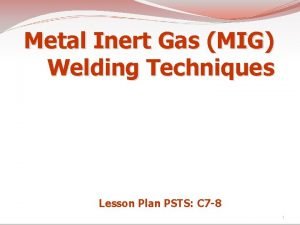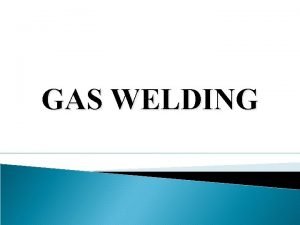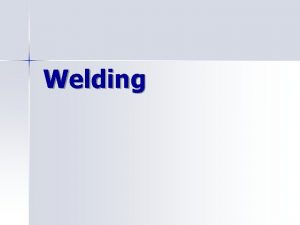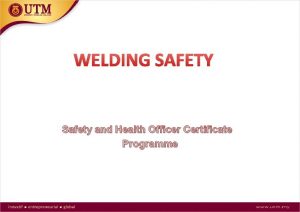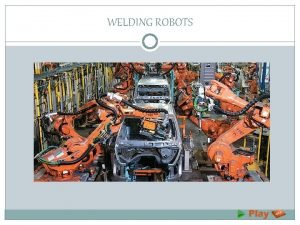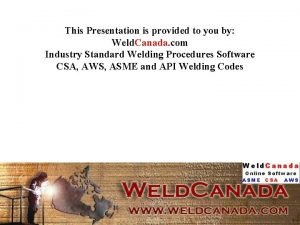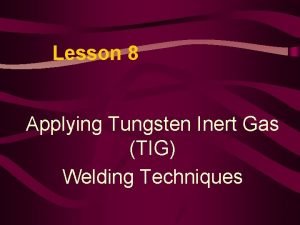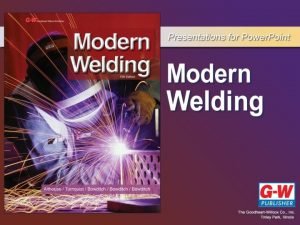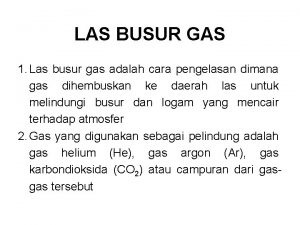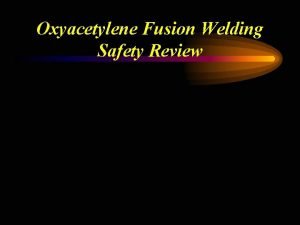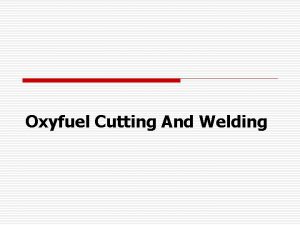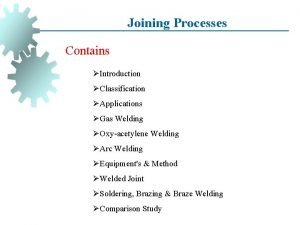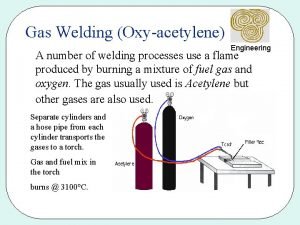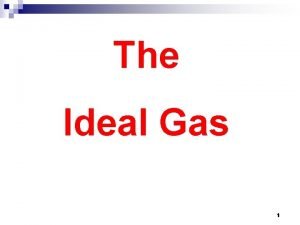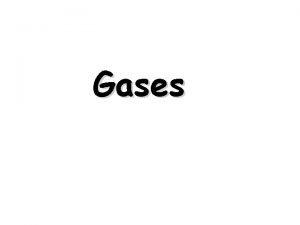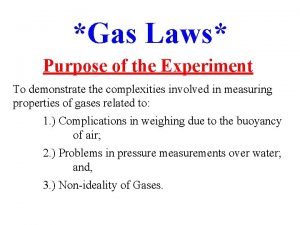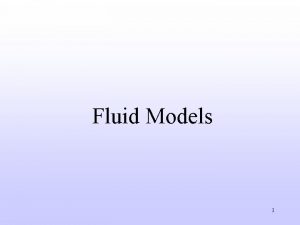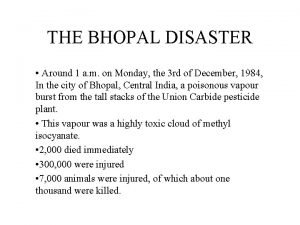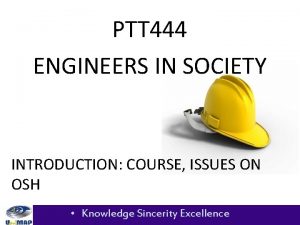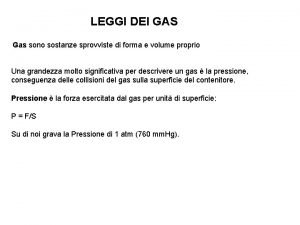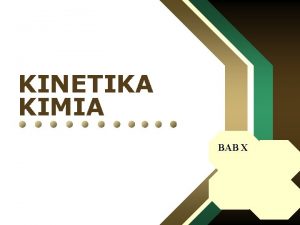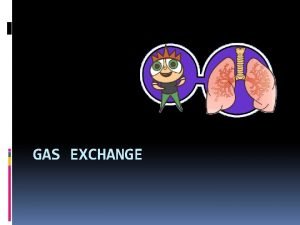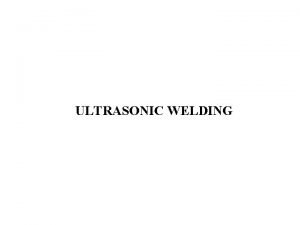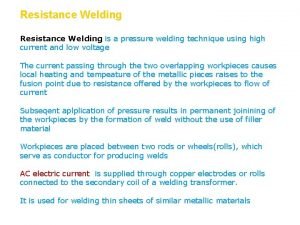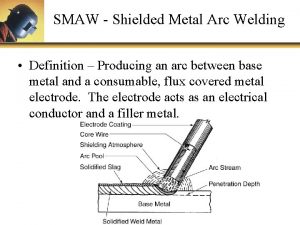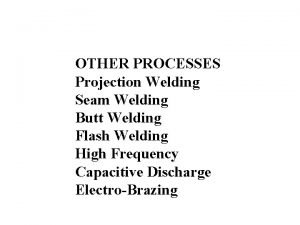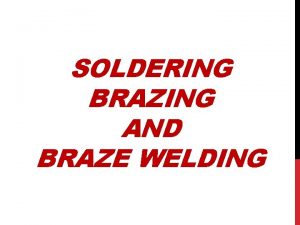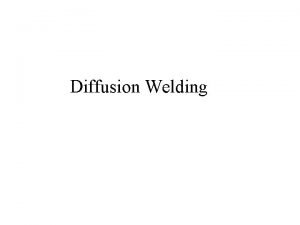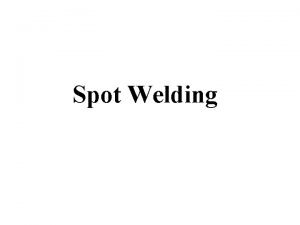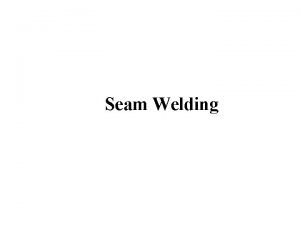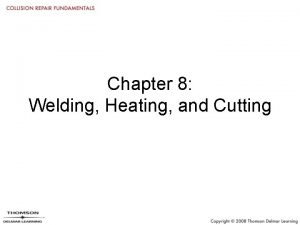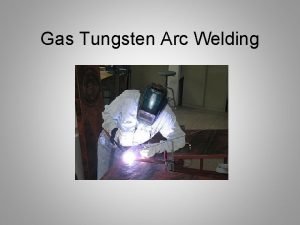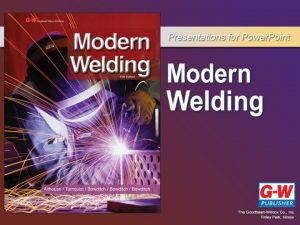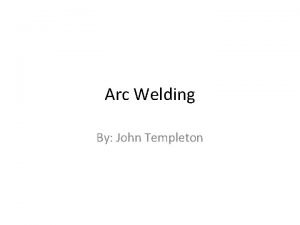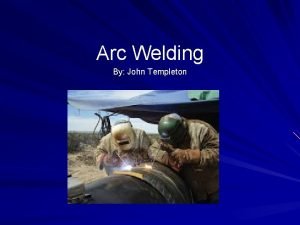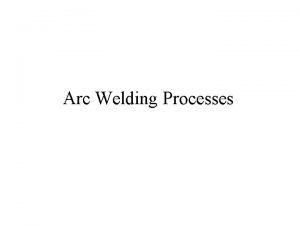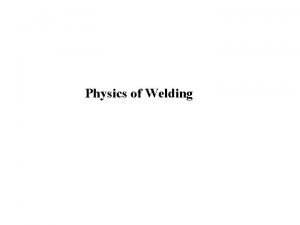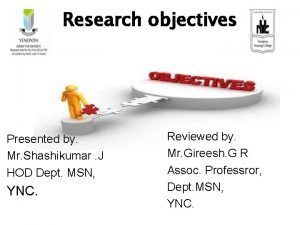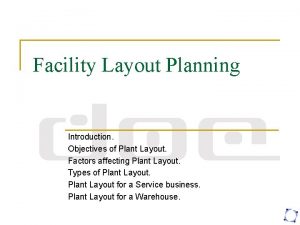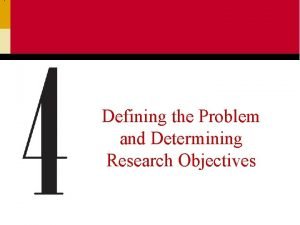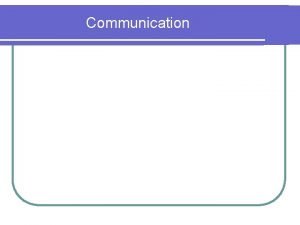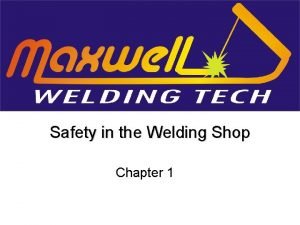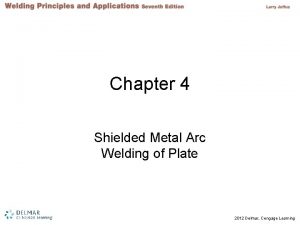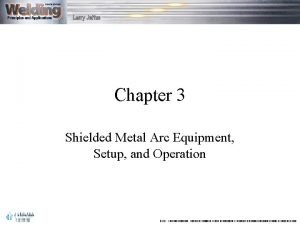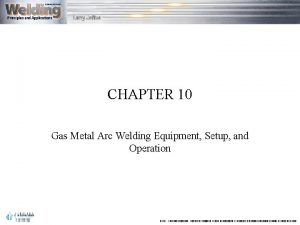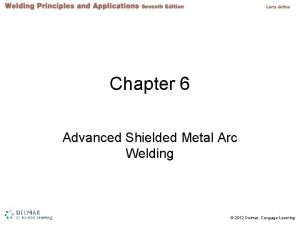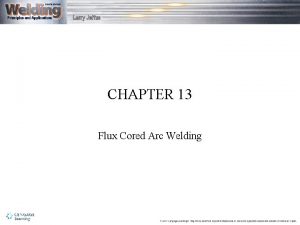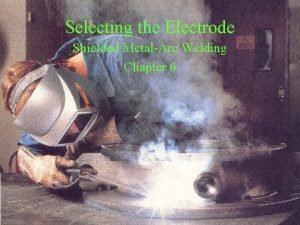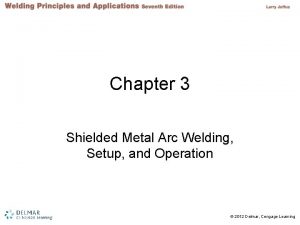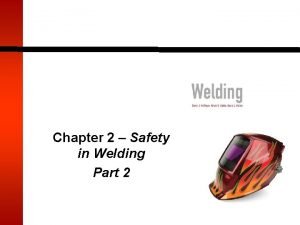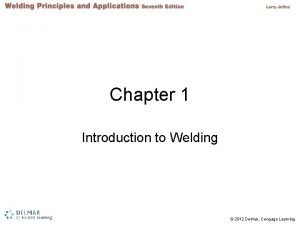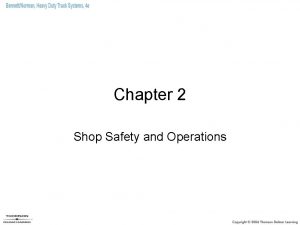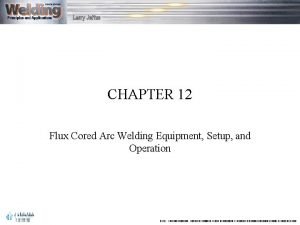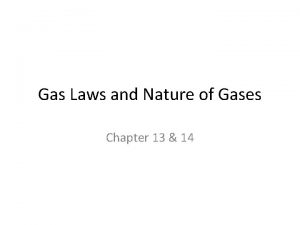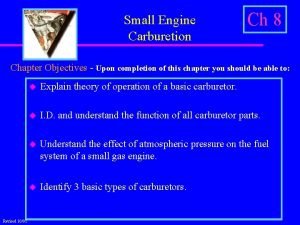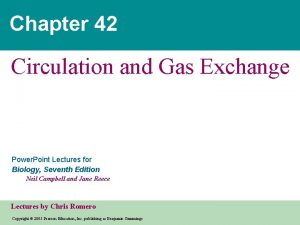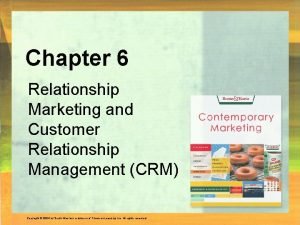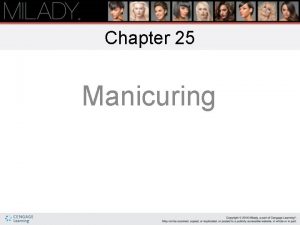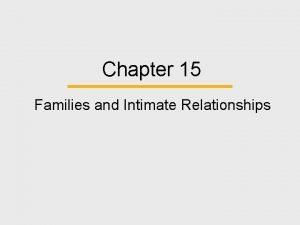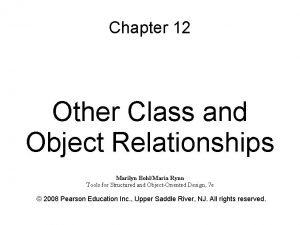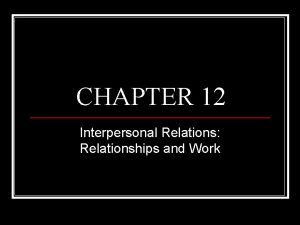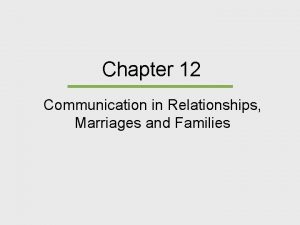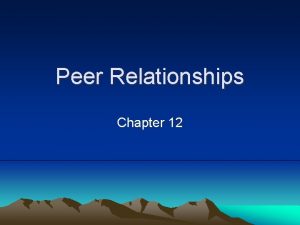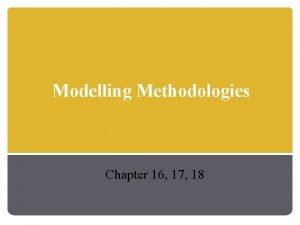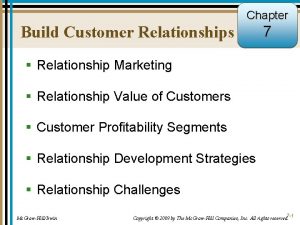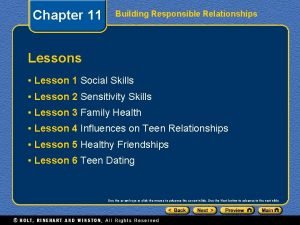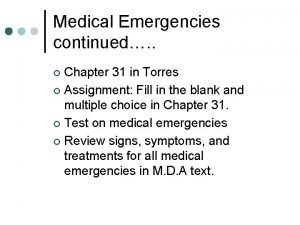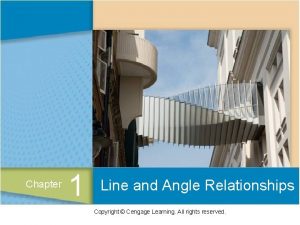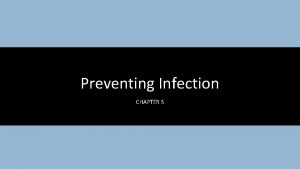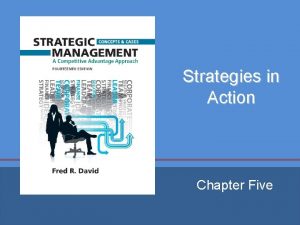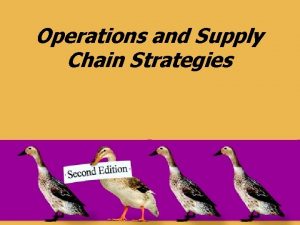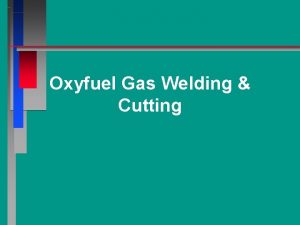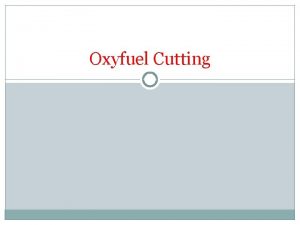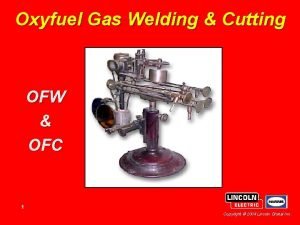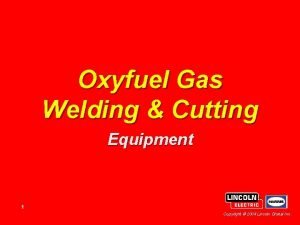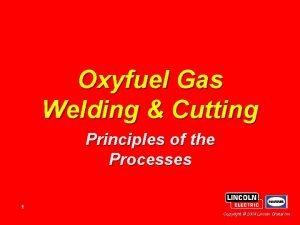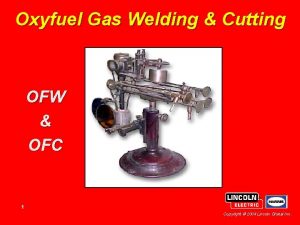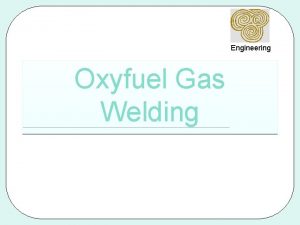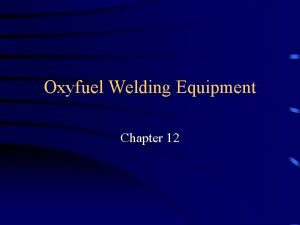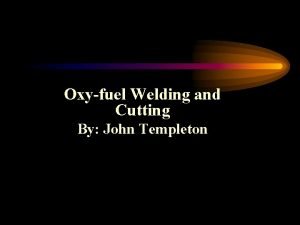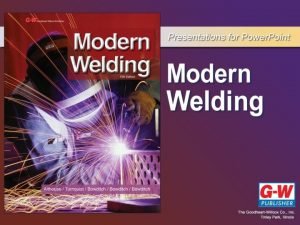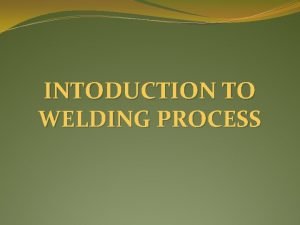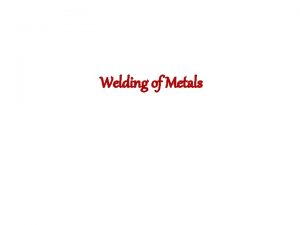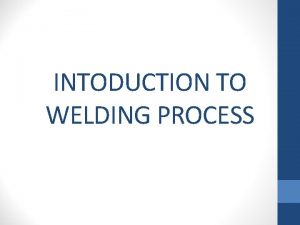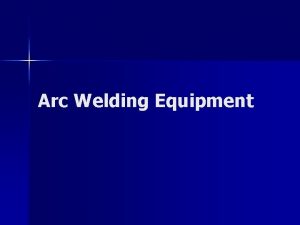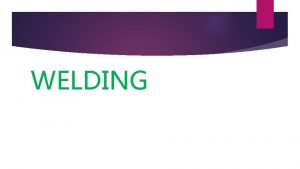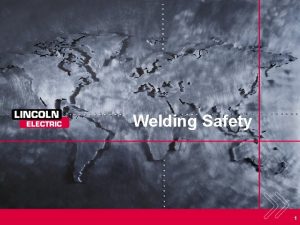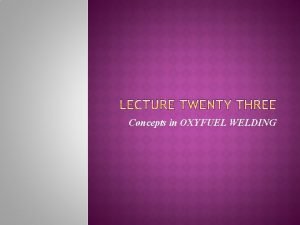Chapter 12 Oxyfuel Gas Welding Objectives Define welding


Chapter 12 Oxyfuel Gas Welding

Objectives • Define welding as a joining process. • Demonstrate the safe storage, handling, and movement of oxygen, acetylene, and other fuel gas cylinders. • Accurately and safely assemble an oxyacetylene welding outfit. • Demonstrate the correct method for testing for leaks on all components of the oxyacetylene welding outfit. • Demonstrate the correct method of starting and shutting down an oxyacetylene welding outfit. © Goodheart-Willcox Co. , Inc. Permission granted to reproduce for educational use only.

Objectives • Select the correct tip size, working pressures, and welding procedure to use for welding various thicknesses of mild steel in various positions. • Adjust a neutral flame and other types of welding flames. • Recognize good and defective welds. • Pass a test on the safe practices and procedures to follow for oxyfuel gas welding. • Run a continuous weld pool on base metal using an oxyacetylene welding torch. © Goodheart-Willcox Co. , Inc. Permission granted to reproduce for educational use only.

Objectives • Make a quality butt weld, lap weld, inside corner weld, outside corner weld, and T-joint weld showing complete penetration. • Make a quality butt weld in the flat, vertical, horizontal, and overhead positions. © Goodheart-Willcox Co. , Inc. Permission granted to reproduce for educational use only.

Oxyfuel Gas Welding • Oxyfuel gas welding is widely used for repair work, fabricating small projects, and cutting • The fundamentals include basic skills important to other forms of welding • The process is a popular manual process • It is easy for beginners to observe the fusion process during oxyfuel gas welding © Goodheart-Willcox Co. , Inc. Permission granted to reproduce for educational use only.

Introduction to Oxyfuel Gas Welding • Oxyfuel gas welding – Is a metal-working process – Joins pieces of metal by heating them with a gas flame to the melting point – Allows molten portions to fuse together • Continuous practice is necessary to develop and maintain a high standard of skill as a welder © Goodheart-Willcox Co. , Inc. Permission granted to reproduce for educational use only.

Brazing and Soldering • Brazing is done when two metals, which are not melted, are joined with a third piece that melts at temperatures above 840°F • Soldering occurs when two metals, which are not melted, are joined by a third metal that has a melting point below 840°F © Goodheart-Willcox Co. , Inc. Permission granted to reproduce for educational use only.

Oxyfuel Gas Welding Process • Using an oxyfuel gas flame as a heat source is a popular welding method • This method provides a clean flame with an extremely high temperature that produces the heat needed for welding © Goodheart-Willcox Co. , Inc. Permission granted to reproduce for educational use only.

Welding Flames • In oxyfuel gas • To obtain more heat, welding, a very a torch tip with a intense, concentrated larger orifice is used flame is applied to the to produce a larger metal flame • The molten pools run • The thickness of the together and fuse metal that can be welded depends on • The edges of the two the quantity of fuel pieces become one gas burned per unit of time © Goodheart-Willcox Co. , Inc. Permission granted to reproduce for educational use only.

Welding Flames • There are several commonly used oxyfuel gas welding and cutting flames – – Oxyacetylene used for welding and cutting Oxyhydrogen used for welding and cutting Oxynatural gas used for cutting Oxypropane used for cutting © Goodheart-Willcox Co. , Inc. Permission granted to reproduce for educational use only.

Welding Flames • Harmful flames are created when the wrong proportions of oxygen and fuel gas are used • If there is too much oxygen, an oxidizing flame burns the metal • If there is too much fuel gas, a carburizing flame results © Goodheart-Willcox Co. , Inc. Permission granted to reproduce for educational use only.

Safety • Because hydrogen does not contain any carbon, an oxyhydrogen flame will not become carburizing © Goodheart-Willcox Co. , Inc. Permission granted to reproduce for educational use only.

Welding Flames • An oxyacetylene welding flame is the hottest oxyfuel gas flame • It is hot enough to melt common metals (Smith Equipment) © Goodheart-Willcox Co. , Inc. Permission granted to reproduce for educational use only.

Oxyfuel Gas Welding Outfit • The oxyfuel gas welding outfit consists of – The oxygen and fuel gas cylinders – The regulators, hoses and hose fittings for each gas – A welding torch • There are two types of gas welding torches: a positive-pressure torch and an injector-type torch © Goodheart-Willcox Co. , Inc. Permission granted to reproduce for educational use only.

Oxyfuel Gas Welding Outfit • The welding station includes the welding outfit plus a welding table, holding fixtures, ventilation, and possibly a booth • This illustration shows a portable welding and cutting station © Goodheart-Willcox Co. , Inc. Permission granted to reproduce for educational use only.

Assembling the Welding Outfit • Oxygen cylinders and most fuel gas cylinders are usually owned by the companies that supply the gases • The rest of the welding equipment is usually owned by the welder or employer • Great care must be used when handling cylinders • Before doing welding, make sure the equipment is properly assembled • Before attaching a regulator to a cylinder, the cylinder opening should be cleaned out by cracking • Be sure the regulator nut fits the cylinder valve fitting properly © Goodheart-Willcox Co. , Inc. Permission granted to reproduce for educational use only.

Safety • Fuel gas and oxygen • Be certain that there cylinder valves have is no exposed flame in different threads the area and that the cylinder opening is • Fuel cylinders are pointed away from usually fitted with leftany person or hand threads possible flame source • Oxygen cylinder when a fuel gas valves are fitted with cylinder is blown right-hand threads clean • The thread diameters are also different © Goodheart-Willcox Co. , Inc. Permission granted to reproduce for educational use only.

Assembling the Welding Outfit • A flashback arrestor should be installed between the regulator and the hose • A check valve should be installed between the hose and the torch body • To test for leaks, put a soapsuds solution on the outside of the joints suspected of leaking (BOC) © Goodheart-Willcox Co. , Inc. Permission granted to reproduce for educational use only.

Safety • A flame or oil of any kind should never be used to test for leaks • Do not use the system until the leaking joints are repaired • After the parts have been replaced or repaired, perform another leak test before lighting the torch © Goodheart-Willcox Co. , Inc. Permission granted to reproduce for educational use only.

Handling Cylinders Safely • A cylinder truck should be used to move a cylinder • The cylinder must be properly secured so that it cannot tip or fall off the truck • Avoid storing or using cylinders in extremely hot places © Goodheart-Willcox Co. , Inc. Permission granted to reproduce for educational use only.

Safety • Cylinders should never be dropped or tipped over • The cylinder safety cap, which encloses and protects the cylinder, should always be in place when the cylinder is not in use or is being moved © Goodheart-Willcox Co. , Inc. Permission granted to reproduce for educational use only.

Selecting a Torch Tip • The tip size of a welding torch is determined by the size of the orifice • The orifice size determines the amount of fuel gas and oxygen fed to the flame • If the torch tip orifice is too small, not enough heat is available to melt the metal • If the torch tip is too large, poor welds result © Goodheart-Willcox Co. , Inc. Permission granted to reproduce for educational use only.

Turning On the Oxyacetylene Outfit • Visually check the condition of the equipment • Inspect the regulators • Turn the regulator adjusting screws all the way out before opening the cylinder valves • Slowly open the acetylene valve using the proper size wrench © Goodheart-Willcox Co. , Inc. Permission granted to reproduce for educational use only.

Safety • Stand to one side of the regulator when opening the cylinder valves • A burst regulator or gauge could cause severe injury • Leave the wrench on the valve in case an emergency shutoff is needed © Goodheart-Willcox Co. , Inc. Permission granted to reproduce for educational use only.

Turning On the Oxyacetylene Outfit • Open the oxygen cylinder valve very slowly • Open the acetylene torch valve one turn • Turn the regulator adjusting screw in slowly until the correct pressure is indicated • Open the torch oxygen valve one turn • Turn the regulator adjusting screw in until the correct pressure is indicated © Goodheart-Willcox Co. , Inc. Permission granted to reproduce for educational use only.

Safety • Never use acetylene • If so, close the oxygen gas at a gauge and acetylene cylinder pressure above valves immediately 15 psig (103 k. Pa) • An increase in • Check the lowpressure indicates pressure gauges after that the pressure a few seconds to see regulator valve is if the reading has leaking increased from the working pressure that • Do not point a torch at was set yourself or others © Goodheart-Willcox Co. , Inc. Permission granted to reproduce for educational use only.

Lighting a Positive-Pressure Torch • Open the acetylene torch valve no more than 1/16 turn and use a spark lighter to ignite the gas • Continue to open the torch valve until the acetylene flame jumps away from the tip • Another method for determining the correct amount of acetylene is to increase the flow until the flame becomes turbulent © Goodheart-Willcox Co. , Inc. Permission granted to reproduce for educational use only.

Lighting a Positive-Pressure Torch • After the acetylene is regulated, slowly open the oxygen valve on the torch • If the torch burns with an irregular contour to the cone, the flame is called a carburizing flame © Goodheart-Willcox Co. , Inc. Permission granted to reproduce for educational use only.

Regulator Gauge Readings • After adjusting the pressure on the regulator lowpressure gauge, the torch valve is closed • There is a slight rise in pressure on the low-pressure gauge, which is normal • The flowing pressure is always lower than the pressure when the torch valve is closed © Goodheart-Willcox Co. , Inc. Permission granted to reproduce for educational use only.

Safety • The low-pressure gauge reading could continue to rise after the torch valve is turned off • This indicates a leaking regulator nozzle and seat • Turn off the cylinder valve immediately • Replace or repair the regulator before using the station again © Goodheart-Willcox Co. , Inc. Permission granted to reproduce for educational use only.

Turning On an Outfit and Lighting an Injector. Type Torch • Inspect the equipment • Open the oxygen to make sure all parts cylinder valve very are in good operating slowly until the highcondition pressure gauge reaches its maximum • Inspect the regulators reading • The adjusting screws • Turn the valve all the should be turned all way open the way out before opening the cylinder valves © Goodheart-Willcox Co. , Inc. Permission granted to reproduce for educational use only.

Safety • Never stand in front of the regulator when opening the cylinder valves • Injury may result if the regulator or gauges rupture © Goodheart-Willcox Co. , Inc. Permission granted to reproduce for educational use only.

Turning On an Outfit and Lighting an Injector-Type Torch • Slowly open the acetylene cylinder valve 1/4 to 1/2 turn • To adjust the oxygen torch pressure, open the torch oxygen valve fully • Turn the adjusting screw on the oxygen regulator until the low-pressure gauge shows the appropriate pressure © Goodheart-Willcox Co. , Inc. Permission granted to reproduce for educational use only.

Safety • Check the low-pressure gauge for an indication of regulator failure © Goodheart-Willcox Co. , Inc. Permission granted to reproduce for educational use only.

Turning On an Outfit and Lighting an Injector-Type Torch • • • Purge the system Open the torch oxygen valve 1/2 turn Open the torch acetylene valve 1/4 turn Light the gases at the tip with a lighter Adjust the valves to reach the desired flame © Goodheart-Willcox Co. , Inc. Permission granted to reproduce for educational use only.

Torch Adjustments • A torch can be adjusted to produce the following flame characteristics – Neutral flame – Carburizing flame – Oxidizing flame • A disruption of gas flow at the tip causes a backfire • If the backfire is not stopped, a flashback can result © Goodheart-Willcox Co. , Inc. Permission granted to reproduce for educational use only.

Safety • Flashback is an extremely dangerous occurrence • Action must be taken immediately to extinguish the flame © Goodheart-Willcox Co. , Inc. Permission granted to reproduce for educational use only.

Turning Off a Torch and Shutting Down • If leaving the station for a few minutes, simply turn off the torch – First, turn off the acetylene (fuel) gas – Next, turn off the oxygen torch valve • If the equipment will be idle for more than a few minutes, the outfit should be completely shut down © Goodheart-Willcox Co. , Inc. Permission granted to reproduce for educational use only.

Turning Off a Torch and Shutting Down • Close the acetylene torch valve; then close the oxygen torch valve • Open the hand valves on the torch • Wait until both gauges read zero • Turn the adjusting screws on the regulators all the way out • Lightly close both hand valves on the torch © Goodheart-Willcox Co. , Inc. Permission granted to reproduce for educational use only.

Torch Positions, Movements, and Angles • Moving the torch in the direction that the tip is pointing is called forehand welding • The travel angle is the angle between the axis of the torch and a line perpendicular to the weld axis • The travel angle forehand welding can also be called the push angle © Goodheart-Willcox Co. , Inc. Permission granted to reproduce for educational use only.

Torch Positions, Movements, and Angles • The work angle is the angle between a line perpendicular to the major workpiece and a plane determined by the centerline of the torch and the weld © Goodheart-Willcox Co. , Inc. Permission granted to reproduce for educational use only.

Torch Positions, Movements, and Angles • In backhand welding, the torch tip points back toward the weld bead that was created • The travel angle for backhand welding is also called the drag angle • The tip of the welding torch should be moved slightly as the weld progresses • A weaving, oscillating, or circular motion can be used © Goodheart-Willcox Co. , Inc. Permission granted to reproduce for educational use only.

Running a Continuous Weld Pool • A beginning welder should practice running a continuous weld pool • The size of the weld pool is in proportion to its depth • The appearance of the surface of the pool indicates the type of flame being used • A correctly adjusted flame prevents oxidizing of the surface of the pool © Goodheart-Willcox Co. , Inc. Permission granted to reproduce for educational use only.

Running a Continuous Weld Pool • If the weld pool sinks or sags too far, lower the angle of the torch or increase the speed of movement • The eye of the weld indicates the movement of the molten metal © Goodheart-Willcox Co. , Inc. Permission granted to reproduce for educational use only.

Welds Made without Welding Rods • An overlapped square-groove outside corner joint can be welded without the use of a welding rod • A flanged butt joint also can be welded without welding rod • Both types of joints make good welding exercises for beginners © Goodheart-Willcox Co. , Inc. Permission granted to reproduce for educational use only.

Welds Made with a Welding Rod • To become proficient in gas welding, certain exercises must be planned and practiced • The basic joints are – – – Butt weld joint Lap weld joint Corner joint (inside and outside) T-joint Edge joint © Goodheart-Willcox Co. , Inc. Permission granted to reproduce for educational use only.

Welds Made with a Welding Rod • The basic welding positions – – Flat welding position Horizontal welding position Vertical welding position Overhead welding position © Goodheart-Willcox Co. , Inc. Permission granted to reproduce for educational use only.

Welding Rod in Running a Bead • To obtain a strong weld, metal from a welding rod is fed into the weld pool • This decreases its depth and increases the thickness of the metal in the weld area • The bead in a correctly made groove weld should be slightly convex © Goodheart-Willcox Co. , Inc. Permission granted to reproduce for educational use only.

Welding Rod in Running a Bead • Fillet welds can be made with either a convex or a concave bead • The weld pool condition and the melting rate of the rod can be adjusted with small changes in the torch position © Goodheart-Willcox Co. , Inc. Permission granted to reproduce for educational use only.

Welding Rod in Running a Bead • As the welding rod melts, it becomes necessary to reposition your grip on the welding rod • The beginner is sometimes tempted to use different size welding rods for the same weld, creating problems • A good weld can only be achieved by coordinated handling of the welding torch and the welding rod © Goodheart-Willcox Co. , Inc. Permission granted to reproduce for educational use only.

Safety • Do not place the rod against your body to slide your hand to a new position • Many welders have been injured when the tip of the welding rod burned through their clothing and touched the body © Goodheart-Willcox Co. , Inc. Permission granted to reproduce for educational use only.

Joint Preparation for Plate Welding • Several edge preparations have been developed to make the edges of thick metal ready for welding • Square, bevel, and V-groove joint preparations are the most common © Goodheart-Willcox Co. , Inc. Permission granted to reproduce for educational use only.

Welding Butt Joints • A butt joint weld is one of the most common welds made with the oxyfuel gas torch • The pieces should be clean and flat • The edges should be straight • The welder can prepare the metal for expansion and contraction • After the metal is prepared, light the torch and adjust it to a neutral flame © Goodheart-Willcox Co. , Inc. Permission granted to reproduce for educational use only.

Welding Butt Joints • Bring the torch to the point where the weld is to start • The torch flame melts a pool on the edge of each piece • The weld pool should spread equally over the two pieces • Apply the welding rod to the leading edge of the weld pool until the desired crown is built © Goodheart-Willcox Co. , Inc. Permission granted to reproduce for educational use only.

Welding Butt Joints • The torch tip should be kept at a consistent distance from the weld • The travel angle should remain unchanged • The keyhole procedure is often used on thicker metals that have been beveled © Goodheart-Willcox Co. , Inc. Permission granted to reproduce for educational use only.

Welding Lap Joints • The joint consists of lapping one piece of sheet metal over the one which is to be welded • Before adding the filler metal, a “C” shaped weld pool must be visible © Goodheart-Willcox Co. , Inc. Permission granted to reproduce for educational use only.

Welding Lap Joints • Concentrate the torch flame on the lower surface • The welded portion must be as thick as the original metal • To provide this thickness, add enough welding rod metal to make a convex bead © Goodheart-Willcox Co. , Inc. Permission granted to reproduce for educational use only.

Welding Lap Joints • A plug weld on a lap joint is a circular weld made through a hole in one member of a lap joint, fusing that member to the other • In aircraft tubing repairs, the plug weld is known as a rosette weld • A slot weld is like a plug weld except an elongated hole or slot is cut instead of a round hole © Goodheart-Willcox Co. , Inc. Permission granted to reproduce for educational use only.

Welding Outside Corner Joints • Outside corner joints can be made without using welding rod • The keyhole method can be practiced on this joint • Enough filler metal should be melted to form a convex bead © Goodheart-Willcox Co. , Inc. Permission granted to reproduce for educational use only.

Welding Inside Corner and T-Joints • The preferred method is the have the two pieces set at a 45° angle • This is the flat welding position • The two pieces should be tacked at points along the joint before welding © Goodheart-Willcox Co. , Inc. Permission granted to reproduce for educational use only.

Welding Inside Corner and T-Joints • A second method is to have one piece horizontal and the other vertical • The weld is in the horizontal welding position • When welding this joint, the torch flame is placed close into the corner • To produce fusion at the root of the weld, hold the torch as close as possible without allowing the inner cone of the flame to touch the metal © Goodheart-Willcox Co. , Inc. Permission granted to reproduce for educational use only.

Welding Inside Corner and T-Joints • Neither piece of base metal should show any signs of being undercut • When making a T-joint in horizontal position, use a forward-inclined, half-moon torch motion © Goodheart-Willcox Co. , Inc. Permission granted to reproduce for educational use only.

Safety • Testing a weld for penetration may be done by striking the weldment with a hammer while holding it in a vise • A metal screen or heavy material barrier should be installed around the vise whenever an attempt is made to break a weld • The screen prevents the broken pieces from flying into the shop area © Goodheart-Willcox Co. , Inc. Permission granted to reproduce for educational use only.

Welding Positions • The recognized welding positions are – – – Flat welding position Horizontal welding position (fillet weld) Horizontal welding position (groove weld) Vertical welding position Overhead welding position • Obtaining a good bead is more difficult in horizontal, vertical, and overhead positions © Goodheart-Willcox Co. , Inc. Permission granted to reproduce for educational use only.

Welding in Horizontal Position • This position consists of welding a horizontal joint on a vertical surface • The torch tip should point at a slightly upward angle instead of directly along the weld joint © Goodheart-Willcox Co. , Inc. Permission granted to reproduce for educational use only.

Welding in Vertical Position • Vertical welding consists of welding in a vertical position on a vertical surface • The weld should proceed upward • The torch tip is pointed upward • Some slight torch motion should be used so that the gas stream keeps the molten metal continually in position and prevents sagging © Goodheart-Willcox Co. , Inc. Permission granted to reproduce for educational use only.

Welding in Overhead Position • Overhead welding is the most challenging welding position • The force of the gas velocity in the torch flame plus the surface tension of the metal in the pool helps overcome the pull of gravity on the molten metal • A whipping motion can be used to help keep the molten pool from becoming too hot © Goodheart-Willcox Co. , Inc. Permission granted to reproduce for educational use only.

Safety • The welder’s body, head, and hands should be protected with fire-resistant work clothes, a cap, and gauntlet gloves • The welder should wear high-top shoes or leggings • Pockets should be covered and collars buttoned • Trousers should not have cuffs © Goodheart-Willcox Co. , Inc. Permission granted to reproduce for educational use only.

Backhand Welding • Backhand welding requires the torch to be held at a drag angle of 30° to 45° • The flame should point back at the part that has been welded • Use a whipping motion to move the flame away from the weld at frequent intervals so the edge of the pool can solidify into a bead © Goodheart-Willcox Co. , Inc. Permission granted to reproduce for educational use only.

Multiple-Pass Welding • Multiple-pass welding is welding a number of thin passes on top of one another • It is used primarily to make welds in thick metal • Welding the joint with several passes can help avoid trapping contaminants in the weld • The layers can be made continuously or by using the step method © Goodheart-Willcox Co. , Inc. Permission granted to reproduce for educational use only.

Appearance of a Good Weld • The weld should be of consistent width throughout its length and should be straight • The weld should be slightly crowned or convex • The weld should appear to be fused into the base metal with a blended appearance • The weld should have a clean appearance • The weld should have consistent and efficient penetration and fusion © Goodheart-Willcox Co. , Inc. Permission granted to reproduce for educational use only.

Appearance of a Good Weld • In a lap joint, the most common problem is a lack of fusion along the toe of the bead • Undercutting can also be a problem with welds © Goodheart-Willcox Co. , Inc. Permission granted to reproduce for educational use only.

Safety • When striking metal in a vise, always place a screen around the vise to prevent pieces of metal from flying across the shop • Always wear approved eye protection when performing the test © Goodheart-Willcox Co. , Inc. Permission granted to reproduce for educational use only.

Safety • Welders should know the precautions and follow them for their own safety, for the safety of others, and to protect the equipment © Goodheart-Willcox Co. , Inc. Permission granted to reproduce for educational use only.

Protecting Clothing and Equipment • When welding, wear the following – – Goggles or a helmet with a proper filter lens Leather welding gloves A cap and leather jacket or cape for overhead welding Trousers without cuffs and open pockets • Remove combustibles from pockets • Use fireproof materials as supports © Goodheart-Willcox Co. , Inc. Permission granted to reproduce for educational use only.

Welding or Cutting Tanks and Containers • Do not weld or cut a tank or container unless it has been processed to be safe • Many substances that are not usually flammable or explosive become vaporized (and explosive) when heated to a high temperature © Goodheart-Willcox Co. , Inc. Permission granted to reproduce for educational use only.

Handling Oxygen and Fuel Gas Cylinders • Keep all equipment used with oxygen free of oil • Secure pressurized cylinders so they cannot tip over • Keep cylinder caps screwed on all cylinders that are not is use • Always call oxygen “oxygen”—not air • Mark empty cylinders “MT” with chalk © Goodheart-Willcox Co. , Inc. Permission granted to reproduce for educational use only.

Handling Oxygen and Fuel Gas Cylinders • Store full and empty cylinders separately • Around electrical equipment, insulate the cylinders with wood or rubber • Do not expose cylinders to high temperatures • Tag cylinders with leaks and move them to a safe area • Notify the supplier to pick up leaky cylinders © Goodheart-Willcox Co. , Inc. Permission granted to reproduce for educational use only.

Handling the Oxyfuel Gas Welding Station • Purge the cylinder valves before attaching the regulators • Use a well-fitting wrench to attach regulators and hoses • Purge the hose before attaching to a torch • Do not interchange fittings on hoses • Install flashback arrestors and check valves • Keep hoses away from oil and grease • Examine hoses for leaks © Goodheart-Willcox Co. , Inc. Permission granted to reproduce for educational use only.

Handling the Oxyfuel Gas Welding Station • The adjusting screw • Check for leaks using on the regulator must a nonpetroleumbe turned out before based soap and water opening the cylinder solution valve • Purge oxygen and • Open the cylinder fuel gas valves, valve slowly regulators, lines, and torch passages before • Stand to one side use when opening cylinder valves • Keep regulators in good repair © Goodheart-Willcox Co. , Inc. Permission granted to reproduce for educational use only.

Safety • When purging fuel gas valves, regulators, and hoses, be sure no open flames are near • Fuel gases are flammable • Never use acetylene pressure in excess of 15 psig (103. 4 k. Pa) © Goodheart-Willcox Co. , Inc. Permission granted to reproduce for educational use only.

Welding Regulator Safety • Clean the cylinder • Teflon tape or paste passages prior to fitting made of glycerine and a regulator to a litharge should be used replacement cylinder to seal the threads that connect the gauge to • Examine the condition the regulator of the threads on the regulator and cylinder • Never interchange fittings oxygen and fuel gas regulators or gauges • Use the proper wrench to tighten the regulator fitting to the cylinder © Goodheart-Willcox Co. , Inc. Permission granted to reproduce for educational use only.

Welding Regulator Safety • Turn the regulator • Keep check on the adjustment screw all gauges to ensure that the way out before the pressure does not opening the cylinder continue to go up valve • The pressure to be • Safety-approved used in a gauge regulators incorporate should never be a safety disc on the greater than twolow-pressure side thirds of the maximum calibration of the dial © Goodheart-Willcox Co. , Inc. Permission granted to reproduce for educational use only.

Safety • Aim the cylinder valve opening away from workers and open flames during a cleaning operation • Fuel gas cylinders have left-hand threads • Oxygen cylinders have right-hand threads • Regulators, hoses, and torches have matching threads for fuel gas and oxygen • Never use common pliers or pipe wrenches to tighten regulator fittings • Open the cylinder valve slowly • Do not stand in front of a regulator as the cylinder valve is opened, even when opening it very slowly © Goodheart-Willcox Co. , Inc. Permission granted to reproduce for educational use only.

Handling Torches Safely • Do not put a cold tip in • Backfires are often caused by a dirty tip, a hot tip tube overheated tip, or • Torch hand valves insufficient working should be turned only pressures with the fingertips • Be sure no combustible • Use only a clean wood or leather surface to material is in the area clean the end of a tip when a torch is lighted • Be careful when • Use a spark lighter to cleaning a tip with a tip light a torch cleaner © Goodheart-Willcox Co. , Inc. Permission granted to reproduce for educational use only.

Handling Torches Safely • A flashback is a burning back of the flame into the tip, torch, hose, or even into the regulator • Each welding station should be provided with an insulated hook upon which to hang the unlighted torch © Goodheart-Willcox Co. , Inc. Permission granted to reproduce for educational use only.

Safety • Be sure no flammable material is near the welding station • Be careful that the torch is not directed toward a person while it is being lighted • If a torch backfires, find the trouble and remedy it before continuing to use the torch • In case of a flashback, immediately extinguish the flame and close the cylinders and regulators • Identify and correct the problem before using the outfit again • Always extinguish a torch before allowing it out of your hands © Goodheart-Willcox Co. , Inc. Permission granted to reproduce for educational use only.

Metal Fume Hazards • Many metals release irritating and toxic fumes when heated • Metals that release the most dangerous fumes are cadmium, zinc, lead, and beryllium • Dangerous fumes can be removed using fume extractors © Goodheart-Willcox Co. , Inc. (Nederman, Inc. ) Permission granted to reproduce for educational use only.

Metal Fume Hazards • Cadmium is widely used as a rust-protective coating over steel • Zinc is widely used in die-cast metal parts • Lead is used for some tanks and pipes • Some paints may contain lead oxide pigments • Beryllium is used in aerospace applications where light but stiff metals are needed © Goodheart-Willcox Co. , Inc. Permission granted to reproduce for educational use only.

Safety • The fumes generated by welding, brazing, or cutting cadmium-coated metals are very dangerous • Very thorough ventilation must be provided during these operations • When heated, zinc gives off a vapor that is very irritating to the respiratory system • Very thorough ventilation must be provided when welding zinc © Goodheart-Willcox Co. , Inc. Permission granted to reproduce for educational use only.

Safety • When heating any substance containing lead, thorough ventilation is required • Lead poisoning may occur without any warning since its fumes are not irritating • A person exposed to lead may develop acute lead poisoning • Excellent ventilation must be provided when beryllium is welded since its vapors are toxic © Goodheart-Willcox Co. , Inc. Permission granted to reproduce for educational use only.
- Slides: 92
